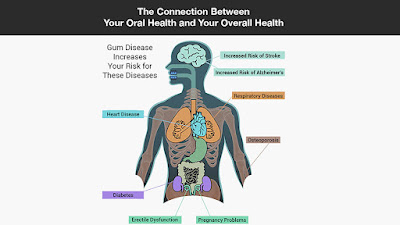 Oral health and overall health are closely linked. More so, the condition of your teeth and gums is crucial to your well being. Flossing is the dental equivalent to exercising for a longer life. You need both, but much more, too.
Oral health and overall health are closely linked. More so, the condition of your teeth and gums is crucial to your well being. Flossing is the dental equivalent to exercising for a longer life. You need both, but much more, too.
- To begin, the mouth is the primary pathway into the body, and an ideal environment for bacteria, fungi and viruses. Take bacteria:
- They can double their numbers every 20 minutes.
- In your mouth are 700 strains, typically 20 billion microorganisms, and they shed an additional 100 billion every day.
- Bacteria harden into plaque.
- They cause:
- Gum disease will exacerbate diabetes.
- People with poor oral health, as for example, those with 10 or fewer natural teeth left, were 66% more likely to die from cardiovascular disease that those with good teeth.
- People who describe their oral health as fair or poor are at increased risk of dying, and will more likely have heart trouble, osteoporosis and diabetes.
- Brush your teeth twice a day with a fluoride toothpaste.
- Clean between teeth regularly, aiming for once a day. ...
- Visit the dentist for routine check-ups and professional cleaning. ...
- Drink fluoridated water. ...
- Don't smoke. ...
- If you are planning to become pregnant, have a dental checkup. ...
- Eat a well-balanced diet.
- Tongue scraper: scrapes off bacteria accumulation and food. Reduces bad breath. Watch this video.
- Soft picks (right): soft, flexible bristles that slide in between the teeth to remove plaque and food debris. Flossing still recommended. Watch this video.
- Plaque disclosing tablets: a dye to highlight plaque. Use at least once/week. Watch this video.
- Use fluoride toothpaste. Fluoride is what protects teeth from tooth decay (cavities). It prevents decay by strengthening the tooth’s hard outer surface, called enamel.
- (This remains a controversial topic. Some feel that it lowers IQ. The John Birch Society in the 1960's thought this was a communist plot. 73% of the U.S. population drink fluoridated water. Hawaii is the only state than bans fluoride in water. Hawaii has the highest rate of tooth decay in the nation! If you live here, used fluoridated tooth paste.)
- Angle the bristles toward the gumline, so they clean between the gums and teeth.
- Brush gently using small, circular motions. Do not scrub hard back and forth.
- Brush all sides of each tooth.
- Brush your tongue.
- Replace your toothbrush when the bristles become worn.
- I add...also brush the inside of your cheeks, carefully.
- Wind: Wind 18″ of floss around middle fingers of each hand.
- Guide: Pinch floss between thumbs and index fingers, leaving a 1″- 2″ length in between. Use thumbs to direct floss between upper teeth.
- Glide: Gently guide floss between teeth using a zig-zag motion. Be careful not to let the floss snap between teeth.
- Shape: Make a C shape around the tooth with the floss.
- Slide: Slide floss up and down against the tooth surface and beneath the gum line. Make sure you floss the back of each tooth too. Floss each tooth thoroughly with a clean section of floss.
- #1 Cocofloss
- #2 Listerine Floss (formerly Reach Floss)
- #3 Glide Oral-B Pro Health
- #4 Superfloss
- #5 Boka Bloss (gluten-free and vegan)
- #6 Dr. Tung's Smart Floss (everything is biodegradable)
- #7 Risewell Floss
- Best soft pick: The Humble Company Floss Picks
- Best for people who don't to want floss: Hydro Floss Oral Irrigator
- Best compact irrigator: Cordless Waterpik Water Flosser
I asked my dental hygienist what was the best floss. She recommended Dr. Tung. I'm trying it, but #6 is about right. Here is my dental cleaning system:
Remember that classic from the Carol Burnett Show featuring Tim Conway as the Dentist?-












Comments
Post a Comment